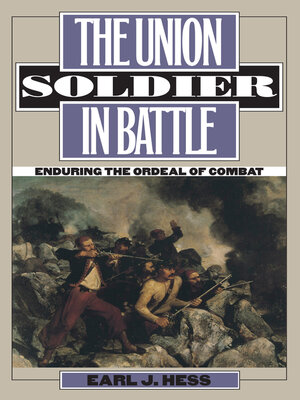The Union Soldier in Battle
ebook ∣ Enduring the Ordeal of Combat · Modern War Studies
By Earl J. Hess

Sign up to save your library
With an OverDrive account, you can save your favorite libraries for at-a-glance information about availability. Find out more about OverDrive accounts.
Find this title in Libby, the library reading app by OverDrive.



Search for a digital library with this title
Title found at these libraries:
| Loading... |
Ribbon of Honor
I saw enough to sicken the heart. . . . The scenes which I witnessed were enough to overthrow all imaginations concerning the glory of war; but, dreadful as they were, I hope and believe that I would be willing to suffer the worst, . . . rather than prove a traitor to the trust which our country reposes in all her sons. —J. Spangler Kieffer, Pennsylvania Militia
With its relentless bloodshed, devastating firepower, and large-scale battles often fought on impossible terrain, the Civil War was a terrifying experience for a volunteer army. Yet, as Earl Hess shows, Union soldiers found the wherewithal to endure such terrors for four long years and emerge victorious.
A vivid reminder that the business of war is killing, Hess's study plunges us into the hellish realms of Civil War combat—a horrific experience crowded with brutalizing sights, sounds, smells, and textures. We share the terror of being shot at for the first time and hear the "grating sound a minie ball makes when it hits a bone instead of the heavy thud when it strikes flesh." We are assaulted by choruses of groans from the wounded and dying and come to understand why some soldiers returned to battle with great dread.
Drawing extensively upon the letters, diaries, and memoirs of Northern soldiers, Hess reveals their deepest fears and shocks, and also their sources of inner strength. By identifying recurrent themes found in these accounts, Hess constructs a multilayered view of the many ways in which these men coped with the challenges of battle. He shows how they were bolstered by belief in God and country, or simply by their sense of duty; how they came to rely on the support of their comrades; and how they learned to muster self-control in order to persevere from one battle to the next.
Although our ability to appreciate war as it was conducted in the previous century has been clouded by our familiarity with modern conflicts, Hess's study conveys that reality with an immediacy rarely matched by other books. Even more, it urges us to reconsider these soldiers not as victims of the battlefield but rather as victors over the worst that war can inflict.






